Qantas Airways Strategic Report: Micro, Macro Analysis & Growth
VerifiedAdded on 2023/06/11
|14
|2982
|233
Report
AI Summary
This strategic report analyzes Qantas Airways, Australia's largest domestic and international airline, using various frameworks to assess its micro and macro environments. The micro environment analysis includes a SWOT analysis, identifying strengths such as a strong international presence and cost-cutting strategies, weaknesses like low profit margins, opportunities for international tie-ups, and threats such as rising fuel prices and increased competition. Porter's Five Forces analysis reveals high buyer power, low supplier power, low threat of substitutes, high rivalry among existing firms, and low threat of new entry. The macro environment is examined through PESTEL analysis, considering political support, economic challenges, social trust, technological innovation, legal compliance, and environmental impact. The report highlights Qantas's competitive advantages, including its dual-brand strategy, structurally advantaged domestic position, innovative loyalty program, premier airline partnerships in Asia, and reputation for operational excellence. Porter’s Generic Strategies and the Ansoff Matrix are applied to further analyze Qantas's strategic positioning and growth options. Finally, the report offers strategic recommendations, emphasizing product differentiation, cost focus, global alliances, business acquisitions, targeted customer segmentation, enhanced customer service, and flexible pricing strategies. Desklib offers a platform for students to access this and other solved assignments.
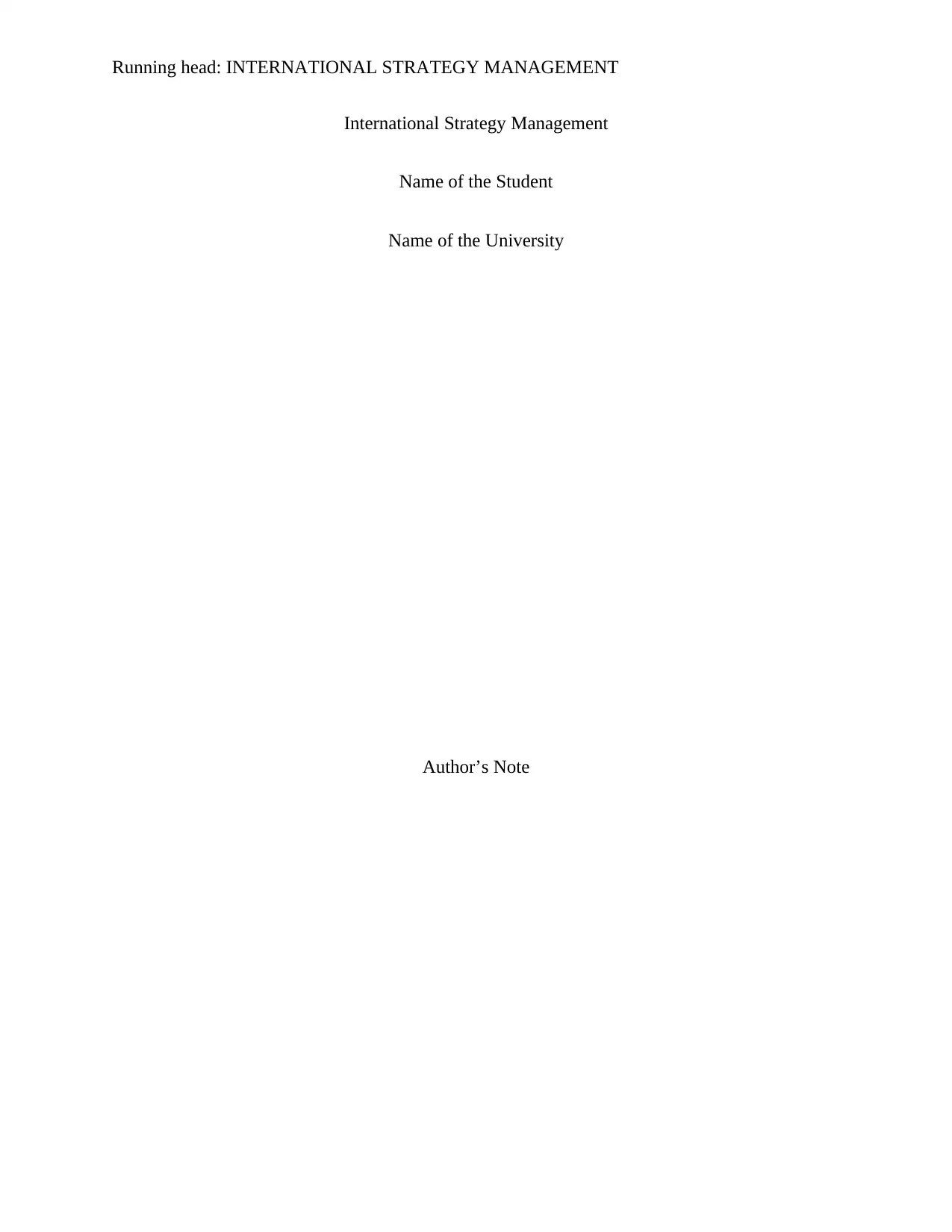
Running head: INTERNATIONAL STRATEGY MANAGEMENT
International Strategy Management
Name of the Student
Name of the University
Author’s Note
International Strategy Management
Name of the Student
Name of the University
Author’s Note
Paraphrase This Document
Need a fresh take? Get an instant paraphrase of this document with our AI Paraphraser
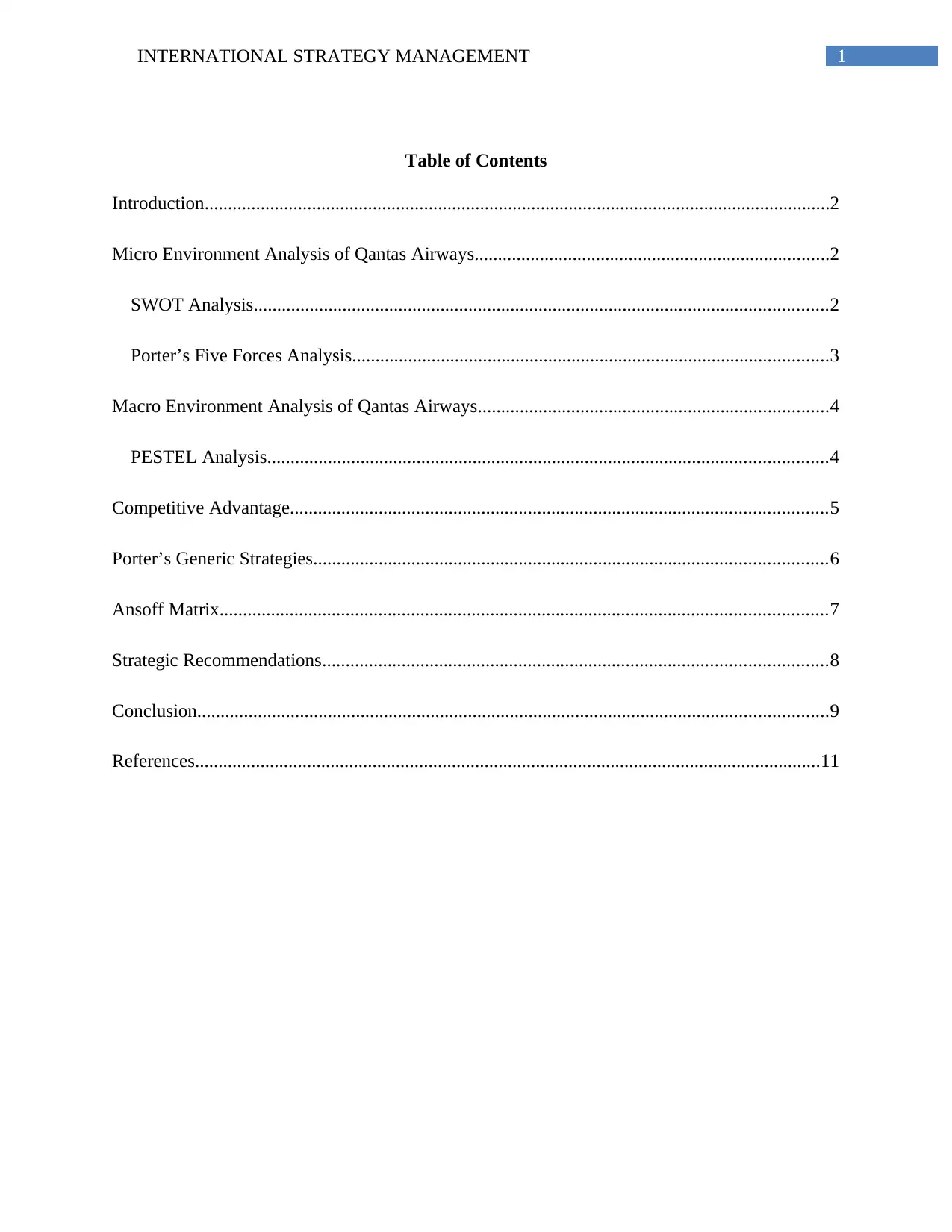
1INTERNATIONAL STRATEGY MANAGEMENT
Table of Contents
Introduction......................................................................................................................................2
Micro Environment Analysis of Qantas Airways............................................................................2
SWOT Analysis...........................................................................................................................2
Porter’s Five Forces Analysis......................................................................................................3
Macro Environment Analysis of Qantas Airways...........................................................................4
PESTEL Analysis........................................................................................................................4
Competitive Advantage...................................................................................................................5
Porter’s Generic Strategies..............................................................................................................6
Ansoff Matrix..................................................................................................................................7
Strategic Recommendations............................................................................................................8
Conclusion.......................................................................................................................................9
References......................................................................................................................................11
Table of Contents
Introduction......................................................................................................................................2
Micro Environment Analysis of Qantas Airways............................................................................2
SWOT Analysis...........................................................................................................................2
Porter’s Five Forces Analysis......................................................................................................3
Macro Environment Analysis of Qantas Airways...........................................................................4
PESTEL Analysis........................................................................................................................4
Competitive Advantage...................................................................................................................5
Porter’s Generic Strategies..............................................................................................................6
Ansoff Matrix..................................................................................................................................7
Strategic Recommendations............................................................................................................8
Conclusion.......................................................................................................................................9
References......................................................................................................................................11
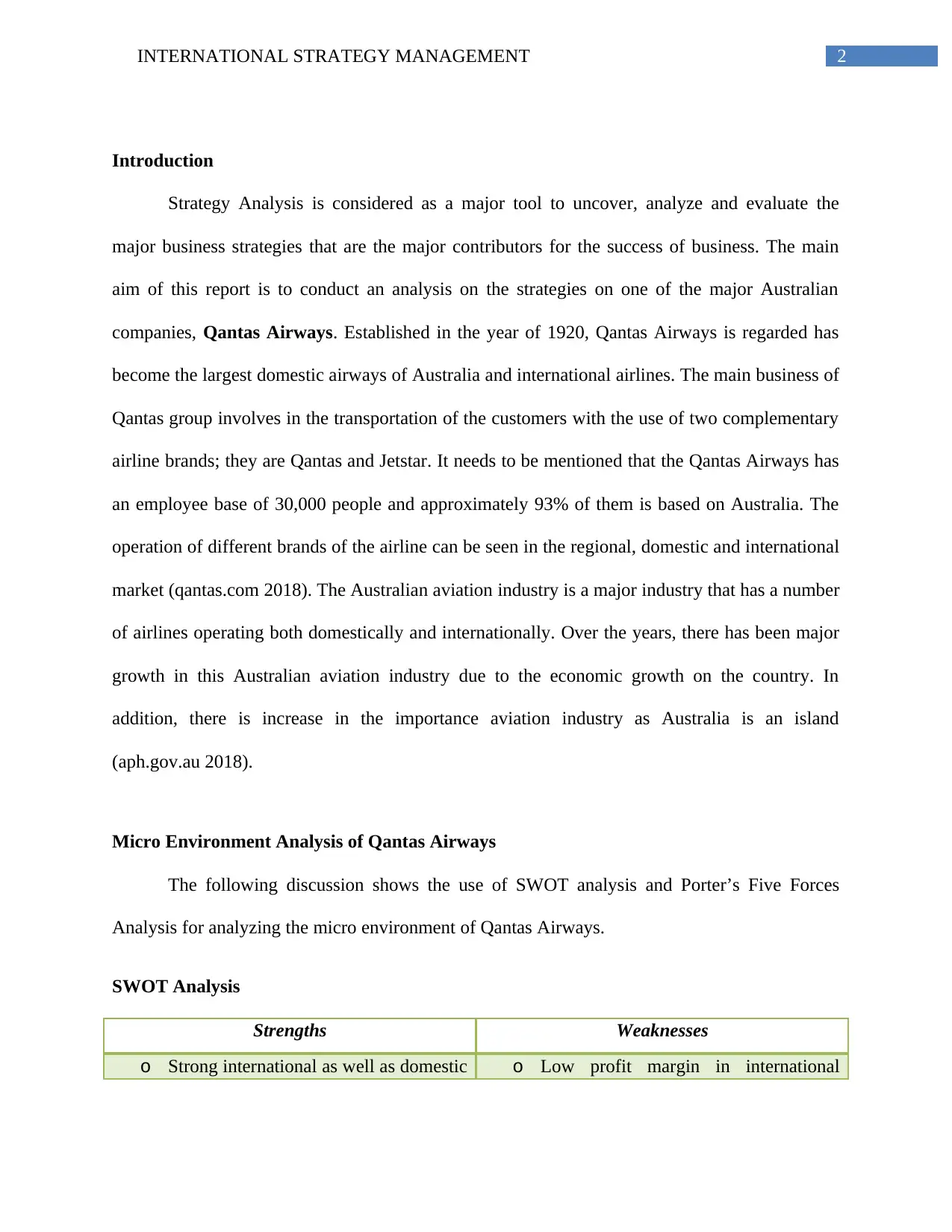
2INTERNATIONAL STRATEGY MANAGEMENT
Introduction
Strategy Analysis is considered as a major tool to uncover, analyze and evaluate the
major business strategies that are the major contributors for the success of business. The main
aim of this report is to conduct an analysis on the strategies on one of the major Australian
companies, Qantas Airways. Established in the year of 1920, Qantas Airways is regarded has
become the largest domestic airways of Australia and international airlines. The main business of
Qantas group involves in the transportation of the customers with the use of two complementary
airline brands; they are Qantas and Jetstar. It needs to be mentioned that the Qantas Airways has
an employee base of 30,000 people and approximately 93% of them is based on Australia. The
operation of different brands of the airline can be seen in the regional, domestic and international
market (qantas.com 2018). The Australian aviation industry is a major industry that has a number
of airlines operating both domestically and internationally. Over the years, there has been major
growth in this Australian aviation industry due to the economic growth on the country. In
addition, there is increase in the importance aviation industry as Australia is an island
(aph.gov.au 2018).
Micro Environment Analysis of Qantas Airways
The following discussion shows the use of SWOT analysis and Porter’s Five Forces
Analysis for analyzing the micro environment of Qantas Airways.
SWOT Analysis
Strengths Weaknesses
o Strong international as well as domestic o Low profit margin in international
Introduction
Strategy Analysis is considered as a major tool to uncover, analyze and evaluate the
major business strategies that are the major contributors for the success of business. The main
aim of this report is to conduct an analysis on the strategies on one of the major Australian
companies, Qantas Airways. Established in the year of 1920, Qantas Airways is regarded has
become the largest domestic airways of Australia and international airlines. The main business of
Qantas group involves in the transportation of the customers with the use of two complementary
airline brands; they are Qantas and Jetstar. It needs to be mentioned that the Qantas Airways has
an employee base of 30,000 people and approximately 93% of them is based on Australia. The
operation of different brands of the airline can be seen in the regional, domestic and international
market (qantas.com 2018). The Australian aviation industry is a major industry that has a number
of airlines operating both domestically and internationally. Over the years, there has been major
growth in this Australian aviation industry due to the economic growth on the country. In
addition, there is increase in the importance aviation industry as Australia is an island
(aph.gov.au 2018).
Micro Environment Analysis of Qantas Airways
The following discussion shows the use of SWOT analysis and Porter’s Five Forces
Analysis for analyzing the micro environment of Qantas Airways.
SWOT Analysis
Strengths Weaknesses
o Strong international as well as domestic o Low profit margin in international
⊘ This is a preview!⊘
Do you want full access?
Subscribe today to unlock all pages.

Trusted by 1+ million students worldwide
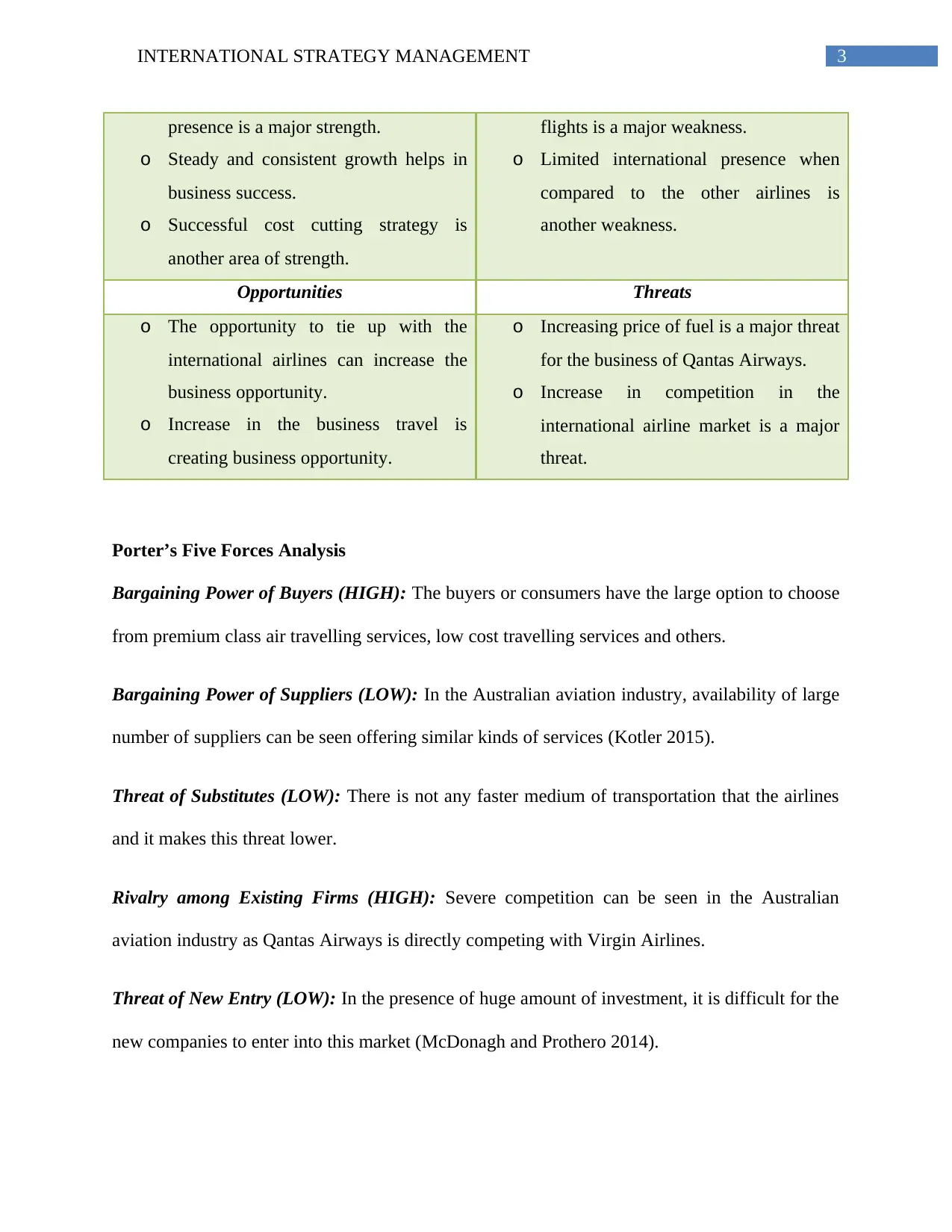
3INTERNATIONAL STRATEGY MANAGEMENT
presence is a major strength.
o Steady and consistent growth helps in
business success.
o Successful cost cutting strategy is
another area of strength.
flights is a major weakness.
o Limited international presence when
compared to the other airlines is
another weakness.
Opportunities Threats
o The opportunity to tie up with the
international airlines can increase the
business opportunity.
o Increase in the business travel is
creating business opportunity.
o Increasing price of fuel is a major threat
for the business of Qantas Airways.
o Increase in competition in the
international airline market is a major
threat.
Porter’s Five Forces Analysis
Bargaining Power of Buyers (HIGH): The buyers or consumers have the large option to choose
from premium class air travelling services, low cost travelling services and others.
Bargaining Power of Suppliers (LOW): In the Australian aviation industry, availability of large
number of suppliers can be seen offering similar kinds of services (Kotler 2015).
Threat of Substitutes (LOW): There is not any faster medium of transportation that the airlines
and it makes this threat lower.
Rivalry among Existing Firms (HIGH): Severe competition can be seen in the Australian
aviation industry as Qantas Airways is directly competing with Virgin Airlines.
Threat of New Entry (LOW): In the presence of huge amount of investment, it is difficult for the
new companies to enter into this market (McDonagh and Prothero 2014).
presence is a major strength.
o Steady and consistent growth helps in
business success.
o Successful cost cutting strategy is
another area of strength.
flights is a major weakness.
o Limited international presence when
compared to the other airlines is
another weakness.
Opportunities Threats
o The opportunity to tie up with the
international airlines can increase the
business opportunity.
o Increase in the business travel is
creating business opportunity.
o Increasing price of fuel is a major threat
for the business of Qantas Airways.
o Increase in competition in the
international airline market is a major
threat.
Porter’s Five Forces Analysis
Bargaining Power of Buyers (HIGH): The buyers or consumers have the large option to choose
from premium class air travelling services, low cost travelling services and others.
Bargaining Power of Suppliers (LOW): In the Australian aviation industry, availability of large
number of suppliers can be seen offering similar kinds of services (Kotler 2015).
Threat of Substitutes (LOW): There is not any faster medium of transportation that the airlines
and it makes this threat lower.
Rivalry among Existing Firms (HIGH): Severe competition can be seen in the Australian
aviation industry as Qantas Airways is directly competing with Virgin Airlines.
Threat of New Entry (LOW): In the presence of huge amount of investment, it is difficult for the
new companies to enter into this market (McDonagh and Prothero 2014).
Paraphrase This Document
Need a fresh take? Get an instant paraphrase of this document with our AI Paraphraser
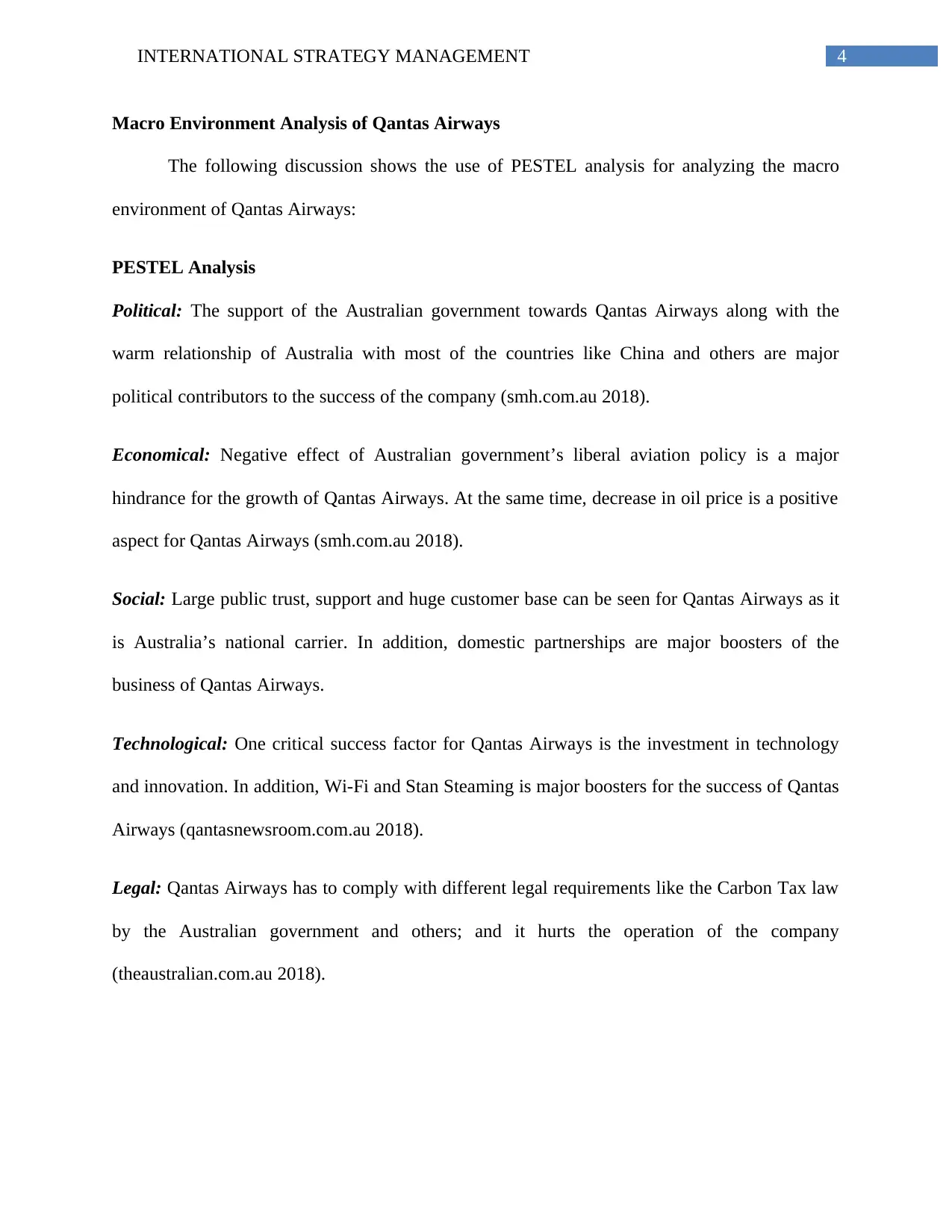
4INTERNATIONAL STRATEGY MANAGEMENT
Macro Environment Analysis of Qantas Airways
The following discussion shows the use of PESTEL analysis for analyzing the macro
environment of Qantas Airways:
PESTEL Analysis
Political: The support of the Australian government towards Qantas Airways along with the
warm relationship of Australia with most of the countries like China and others are major
political contributors to the success of the company (smh.com.au 2018).
Economical: Negative effect of Australian government’s liberal aviation policy is a major
hindrance for the growth of Qantas Airways. At the same time, decrease in oil price is a positive
aspect for Qantas Airways (smh.com.au 2018).
Social: Large public trust, support and huge customer base can be seen for Qantas Airways as it
is Australia’s national carrier. In addition, domestic partnerships are major boosters of the
business of Qantas Airways.
Technological: One critical success factor for Qantas Airways is the investment in technology
and innovation. In addition, Wi-Fi and Stan Steaming is major boosters for the success of Qantas
Airways (qantasnewsroom.com.au 2018).
Legal: Qantas Airways has to comply with different legal requirements like the Carbon Tax law
by the Australian government and others; and it hurts the operation of the company
(theaustralian.com.au 2018).
Macro Environment Analysis of Qantas Airways
The following discussion shows the use of PESTEL analysis for analyzing the macro
environment of Qantas Airways:
PESTEL Analysis
Political: The support of the Australian government towards Qantas Airways along with the
warm relationship of Australia with most of the countries like China and others are major
political contributors to the success of the company (smh.com.au 2018).
Economical: Negative effect of Australian government’s liberal aviation policy is a major
hindrance for the growth of Qantas Airways. At the same time, decrease in oil price is a positive
aspect for Qantas Airways (smh.com.au 2018).
Social: Large public trust, support and huge customer base can be seen for Qantas Airways as it
is Australia’s national carrier. In addition, domestic partnerships are major boosters of the
business of Qantas Airways.
Technological: One critical success factor for Qantas Airways is the investment in technology
and innovation. In addition, Wi-Fi and Stan Steaming is major boosters for the success of Qantas
Airways (qantasnewsroom.com.au 2018).
Legal: Qantas Airways has to comply with different legal requirements like the Carbon Tax law
by the Australian government and others; and it hurts the operation of the company
(theaustralian.com.au 2018).
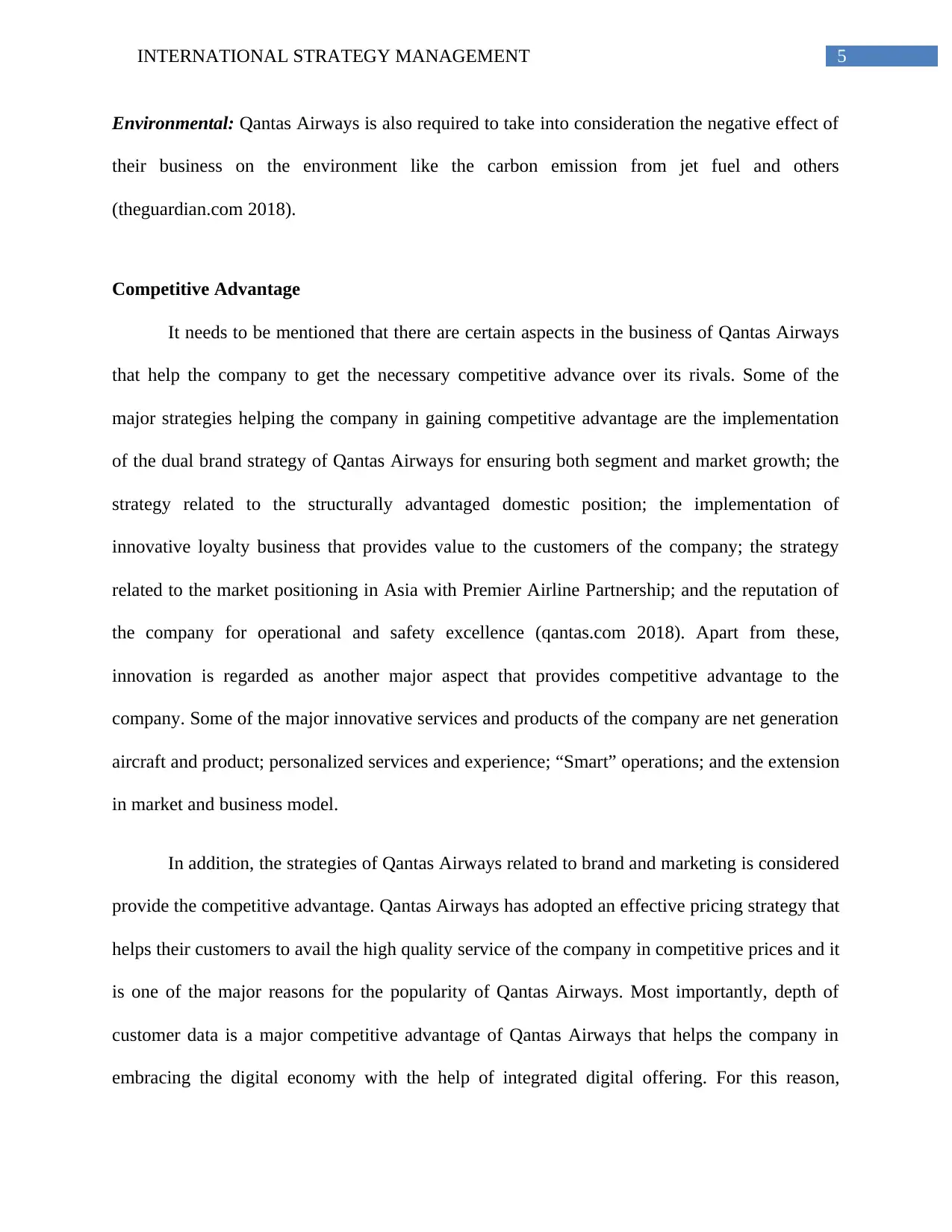
5INTERNATIONAL STRATEGY MANAGEMENT
Environmental: Qantas Airways is also required to take into consideration the negative effect of
their business on the environment like the carbon emission from jet fuel and others
(theguardian.com 2018).
Competitive Advantage
It needs to be mentioned that there are certain aspects in the business of Qantas Airways
that help the company to get the necessary competitive advance over its rivals. Some of the
major strategies helping the company in gaining competitive advantage are the implementation
of the dual brand strategy of Qantas Airways for ensuring both segment and market growth; the
strategy related to the structurally advantaged domestic position; the implementation of
innovative loyalty business that provides value to the customers of the company; the strategy
related to the market positioning in Asia with Premier Airline Partnership; and the reputation of
the company for operational and safety excellence (qantas.com 2018). Apart from these,
innovation is regarded as another major aspect that provides competitive advantage to the
company. Some of the major innovative services and products of the company are net generation
aircraft and product; personalized services and experience; “Smart” operations; and the extension
in market and business model.
In addition, the strategies of Qantas Airways related to brand and marketing is considered
provide the competitive advantage. Qantas Airways has adopted an effective pricing strategy that
helps their customers to avail the high quality service of the company in competitive prices and it
is one of the major reasons for the popularity of Qantas Airways. Most importantly, depth of
customer data is a major competitive advantage of Qantas Airways that helps the company in
embracing the digital economy with the help of integrated digital offering. For this reason,
Environmental: Qantas Airways is also required to take into consideration the negative effect of
their business on the environment like the carbon emission from jet fuel and others
(theguardian.com 2018).
Competitive Advantage
It needs to be mentioned that there are certain aspects in the business of Qantas Airways
that help the company to get the necessary competitive advance over its rivals. Some of the
major strategies helping the company in gaining competitive advantage are the implementation
of the dual brand strategy of Qantas Airways for ensuring both segment and market growth; the
strategy related to the structurally advantaged domestic position; the implementation of
innovative loyalty business that provides value to the customers of the company; the strategy
related to the market positioning in Asia with Premier Airline Partnership; and the reputation of
the company for operational and safety excellence (qantas.com 2018). Apart from these,
innovation is regarded as another major aspect that provides competitive advantage to the
company. Some of the major innovative services and products of the company are net generation
aircraft and product; personalized services and experience; “Smart” operations; and the extension
in market and business model.
In addition, the strategies of Qantas Airways related to brand and marketing is considered
provide the competitive advantage. Qantas Airways has adopted an effective pricing strategy that
helps their customers to avail the high quality service of the company in competitive prices and it
is one of the major reasons for the popularity of Qantas Airways. Most importantly, depth of
customer data is a major competitive advantage of Qantas Airways that helps the company in
embracing the digital economy with the help of integrated digital offering. For this reason,
⊘ This is a preview!⊘
Do you want full access?
Subscribe today to unlock all pages.

Trusted by 1+ million students worldwide
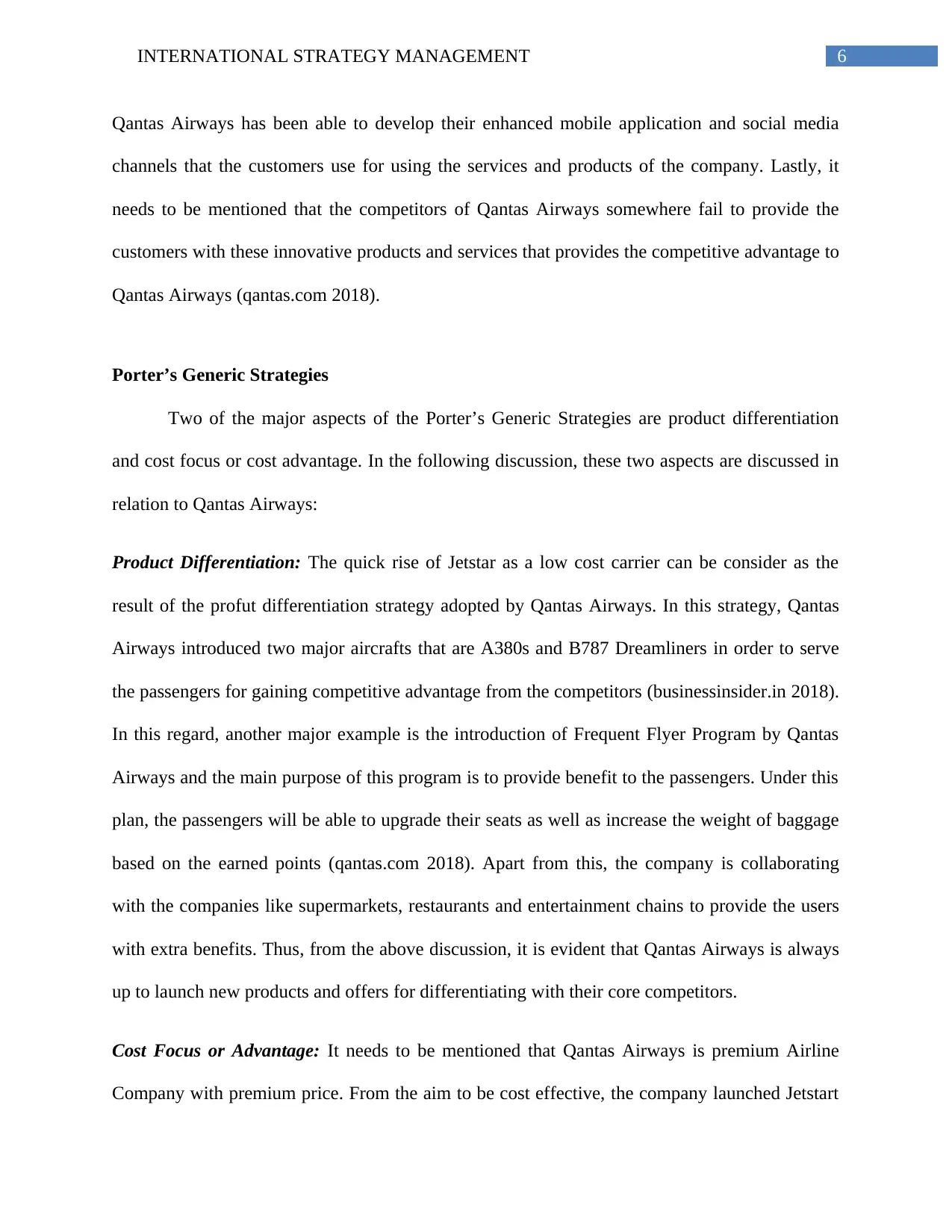
6INTERNATIONAL STRATEGY MANAGEMENT
Qantas Airways has been able to develop their enhanced mobile application and social media
channels that the customers use for using the services and products of the company. Lastly, it
needs to be mentioned that the competitors of Qantas Airways somewhere fail to provide the
customers with these innovative products and services that provides the competitive advantage to
Qantas Airways (qantas.com 2018).
Porter’s Generic Strategies
Two of the major aspects of the Porter’s Generic Strategies are product differentiation
and cost focus or cost advantage. In the following discussion, these two aspects are discussed in
relation to Qantas Airways:
Product Differentiation: The quick rise of Jetstar as a low cost carrier can be consider as the
result of the profut differentiation strategy adopted by Qantas Airways. In this strategy, Qantas
Airways introduced two major aircrafts that are A380s and B787 Dreamliners in order to serve
the passengers for gaining competitive advantage from the competitors (businessinsider.in 2018).
In this regard, another major example is the introduction of Frequent Flyer Program by Qantas
Airways and the main purpose of this program is to provide benefit to the passengers. Under this
plan, the passengers will be able to upgrade their seats as well as increase the weight of baggage
based on the earned points (qantas.com 2018). Apart from this, the company is collaborating
with the companies like supermarkets, restaurants and entertainment chains to provide the users
with extra benefits. Thus, from the above discussion, it is evident that Qantas Airways is always
up to launch new products and offers for differentiating with their core competitors.
Cost Focus or Advantage: It needs to be mentioned that Qantas Airways is premium Airline
Company with premium price. From the aim to be cost effective, the company launched Jetstart
Qantas Airways has been able to develop their enhanced mobile application and social media
channels that the customers use for using the services and products of the company. Lastly, it
needs to be mentioned that the competitors of Qantas Airways somewhere fail to provide the
customers with these innovative products and services that provides the competitive advantage to
Qantas Airways (qantas.com 2018).
Porter’s Generic Strategies
Two of the major aspects of the Porter’s Generic Strategies are product differentiation
and cost focus or cost advantage. In the following discussion, these two aspects are discussed in
relation to Qantas Airways:
Product Differentiation: The quick rise of Jetstar as a low cost carrier can be consider as the
result of the profut differentiation strategy adopted by Qantas Airways. In this strategy, Qantas
Airways introduced two major aircrafts that are A380s and B787 Dreamliners in order to serve
the passengers for gaining competitive advantage from the competitors (businessinsider.in 2018).
In this regard, another major example is the introduction of Frequent Flyer Program by Qantas
Airways and the main purpose of this program is to provide benefit to the passengers. Under this
plan, the passengers will be able to upgrade their seats as well as increase the weight of baggage
based on the earned points (qantas.com 2018). Apart from this, the company is collaborating
with the companies like supermarkets, restaurants and entertainment chains to provide the users
with extra benefits. Thus, from the above discussion, it is evident that Qantas Airways is always
up to launch new products and offers for differentiating with their core competitors.
Cost Focus or Advantage: It needs to be mentioned that Qantas Airways is premium Airline
Company with premium price. From the aim to be cost effective, the company launched Jetstart
Paraphrase This Document
Need a fresh take? Get an instant paraphrase of this document with our AI Paraphraser
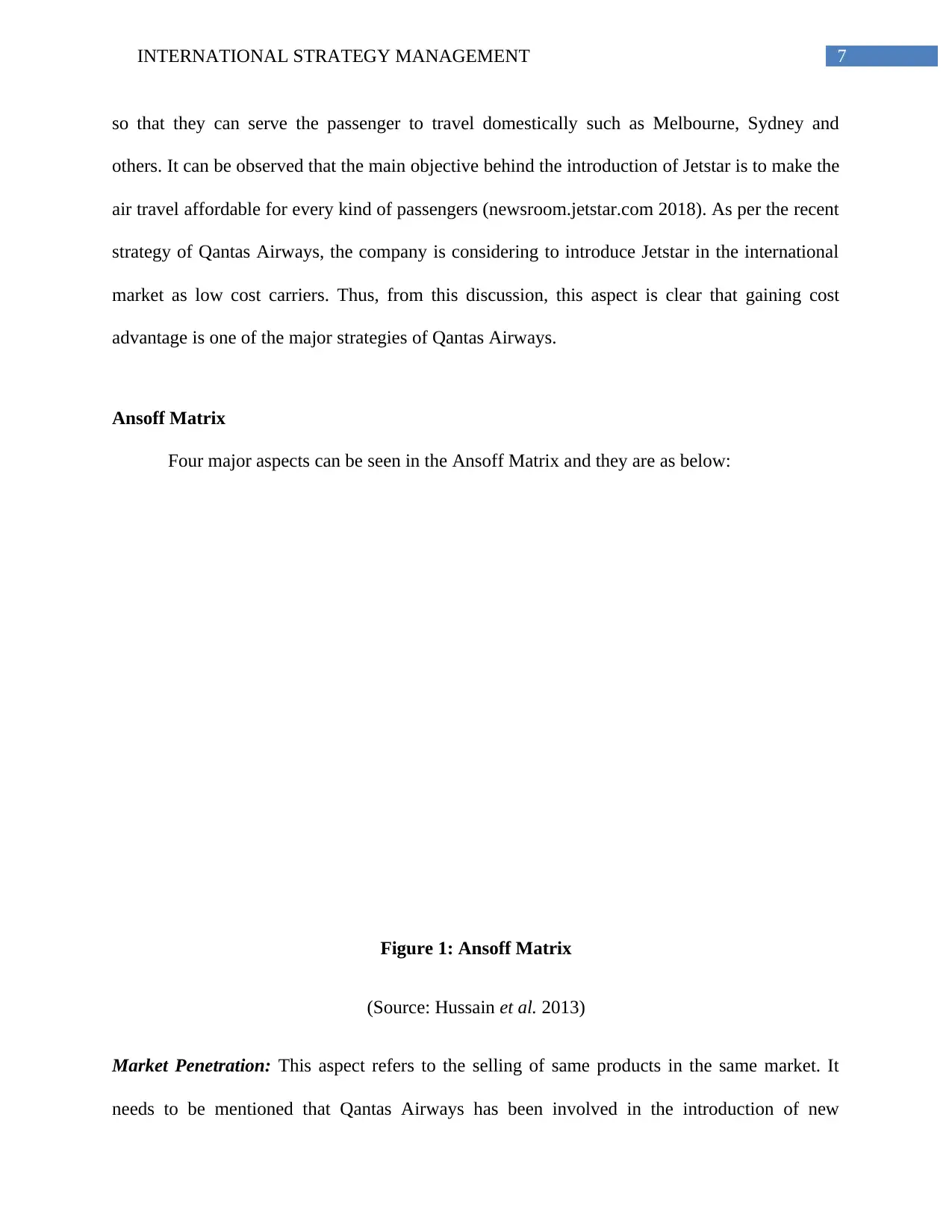
7INTERNATIONAL STRATEGY MANAGEMENT
so that they can serve the passenger to travel domestically such as Melbourne, Sydney and
others. It can be observed that the main objective behind the introduction of Jetstar is to make the
air travel affordable for every kind of passengers (newsroom.jetstar.com 2018). As per the recent
strategy of Qantas Airways, the company is considering to introduce Jetstar in the international
market as low cost carriers. Thus, from this discussion, this aspect is clear that gaining cost
advantage is one of the major strategies of Qantas Airways.
Ansoff Matrix
Four major aspects can be seen in the Ansoff Matrix and they are as below:
Figure 1: Ansoff Matrix
(Source: Hussain et al. 2013)
Market Penetration: This aspect refers to the selling of same products in the same market. It
needs to be mentioned that Qantas Airways has been involved in the introduction of new
so that they can serve the passenger to travel domestically such as Melbourne, Sydney and
others. It can be observed that the main objective behind the introduction of Jetstar is to make the
air travel affordable for every kind of passengers (newsroom.jetstar.com 2018). As per the recent
strategy of Qantas Airways, the company is considering to introduce Jetstar in the international
market as low cost carriers. Thus, from this discussion, this aspect is clear that gaining cost
advantage is one of the major strategies of Qantas Airways.
Ansoff Matrix
Four major aspects can be seen in the Ansoff Matrix and they are as below:
Figure 1: Ansoff Matrix
(Source: Hussain et al. 2013)
Market Penetration: This aspect refers to the selling of same products in the same market. It
needs to be mentioned that Qantas Airways has been involved in the introduction of new
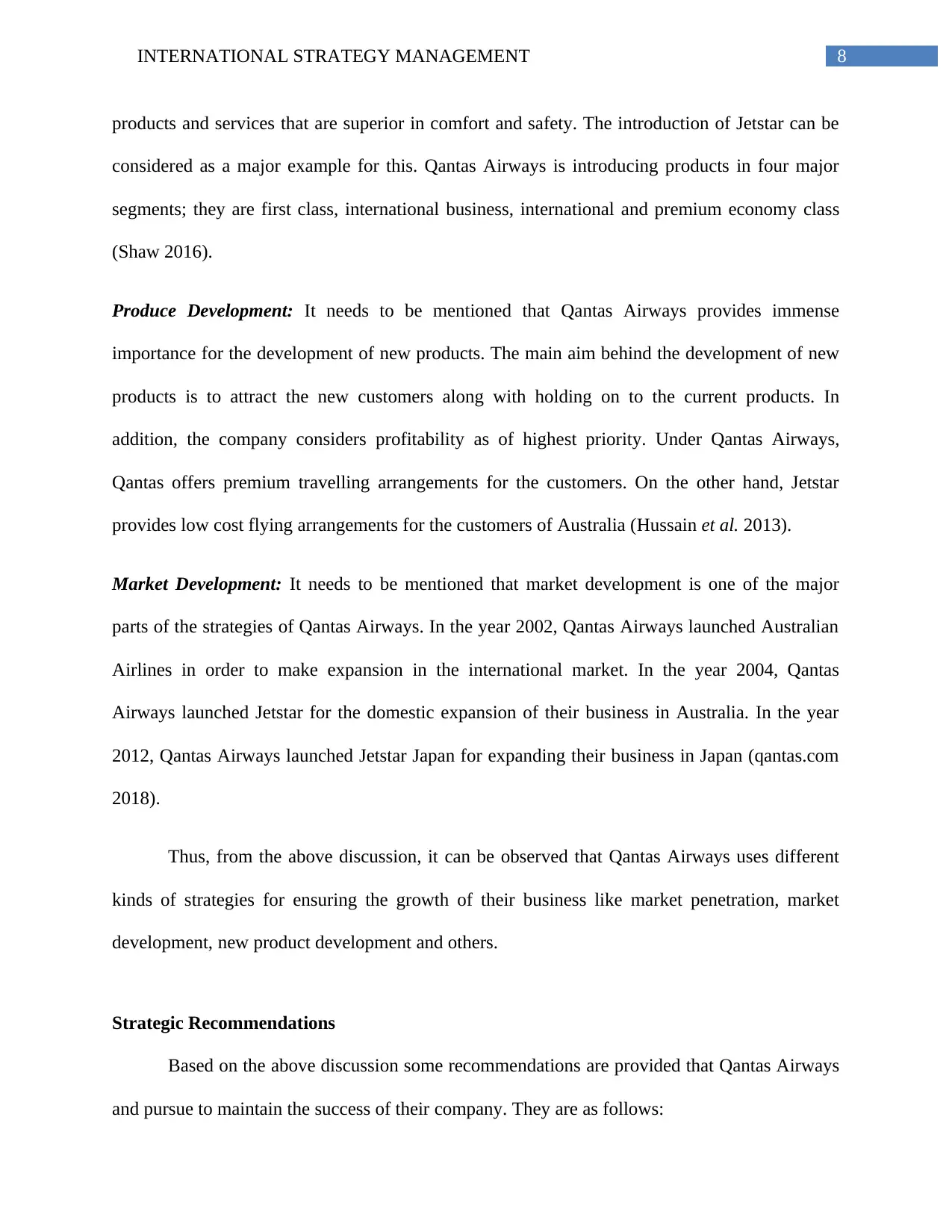
8INTERNATIONAL STRATEGY MANAGEMENT
products and services that are superior in comfort and safety. The introduction of Jetstar can be
considered as a major example for this. Qantas Airways is introducing products in four major
segments; they are first class, international business, international and premium economy class
(Shaw 2016).
Produce Development: It needs to be mentioned that Qantas Airways provides immense
importance for the development of new products. The main aim behind the development of new
products is to attract the new customers along with holding on to the current products. In
addition, the company considers profitability as of highest priority. Under Qantas Airways,
Qantas offers premium travelling arrangements for the customers. On the other hand, Jetstar
provides low cost flying arrangements for the customers of Australia (Hussain et al. 2013).
Market Development: It needs to be mentioned that market development is one of the major
parts of the strategies of Qantas Airways. In the year 2002, Qantas Airways launched Australian
Airlines in order to make expansion in the international market. In the year 2004, Qantas
Airways launched Jetstar for the domestic expansion of their business in Australia. In the year
2012, Qantas Airways launched Jetstar Japan for expanding their business in Japan (qantas.com
2018).
Thus, from the above discussion, it can be observed that Qantas Airways uses different
kinds of strategies for ensuring the growth of their business like market penetration, market
development, new product development and others.
Strategic Recommendations
Based on the above discussion some recommendations are provided that Qantas Airways
and pursue to maintain the success of their company. They are as follows:
products and services that are superior in comfort and safety. The introduction of Jetstar can be
considered as a major example for this. Qantas Airways is introducing products in four major
segments; they are first class, international business, international and premium economy class
(Shaw 2016).
Produce Development: It needs to be mentioned that Qantas Airways provides immense
importance for the development of new products. The main aim behind the development of new
products is to attract the new customers along with holding on to the current products. In
addition, the company considers profitability as of highest priority. Under Qantas Airways,
Qantas offers premium travelling arrangements for the customers. On the other hand, Jetstar
provides low cost flying arrangements for the customers of Australia (Hussain et al. 2013).
Market Development: It needs to be mentioned that market development is one of the major
parts of the strategies of Qantas Airways. In the year 2002, Qantas Airways launched Australian
Airlines in order to make expansion in the international market. In the year 2004, Qantas
Airways launched Jetstar for the domestic expansion of their business in Australia. In the year
2012, Qantas Airways launched Jetstar Japan for expanding their business in Japan (qantas.com
2018).
Thus, from the above discussion, it can be observed that Qantas Airways uses different
kinds of strategies for ensuring the growth of their business like market penetration, market
development, new product development and others.
Strategic Recommendations
Based on the above discussion some recommendations are provided that Qantas Airways
and pursue to maintain the success of their company. They are as follows:
⊘ This is a preview!⊘
Do you want full access?
Subscribe today to unlock all pages.

Trusted by 1+ million students worldwide
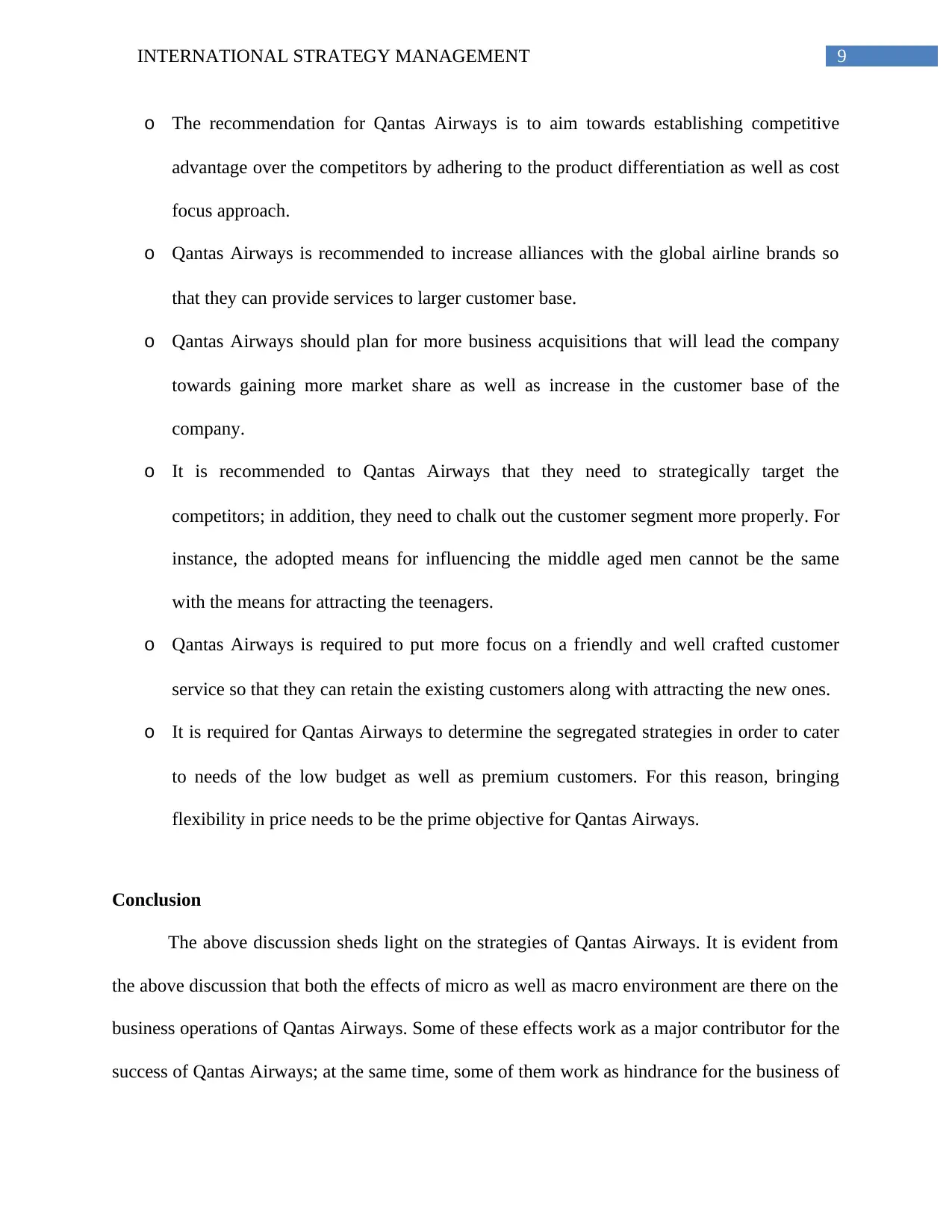
9INTERNATIONAL STRATEGY MANAGEMENT
o The recommendation for Qantas Airways is to aim towards establishing competitive
advantage over the competitors by adhering to the product differentiation as well as cost
focus approach.
o Qantas Airways is recommended to increase alliances with the global airline brands so
that they can provide services to larger customer base.
o Qantas Airways should plan for more business acquisitions that will lead the company
towards gaining more market share as well as increase in the customer base of the
company.
o It is recommended to Qantas Airways that they need to strategically target the
competitors; in addition, they need to chalk out the customer segment more properly. For
instance, the adopted means for influencing the middle aged men cannot be the same
with the means for attracting the teenagers.
o Qantas Airways is required to put more focus on a friendly and well crafted customer
service so that they can retain the existing customers along with attracting the new ones.
o It is required for Qantas Airways to determine the segregated strategies in order to cater
to needs of the low budget as well as premium customers. For this reason, bringing
flexibility in price needs to be the prime objective for Qantas Airways.
Conclusion
The above discussion sheds light on the strategies of Qantas Airways. It is evident from
the above discussion that both the effects of micro as well as macro environment are there on the
business operations of Qantas Airways. Some of these effects work as a major contributor for the
success of Qantas Airways; at the same time, some of them work as hindrance for the business of
o The recommendation for Qantas Airways is to aim towards establishing competitive
advantage over the competitors by adhering to the product differentiation as well as cost
focus approach.
o Qantas Airways is recommended to increase alliances with the global airline brands so
that they can provide services to larger customer base.
o Qantas Airways should plan for more business acquisitions that will lead the company
towards gaining more market share as well as increase in the customer base of the
company.
o It is recommended to Qantas Airways that they need to strategically target the
competitors; in addition, they need to chalk out the customer segment more properly. For
instance, the adopted means for influencing the middle aged men cannot be the same
with the means for attracting the teenagers.
o Qantas Airways is required to put more focus on a friendly and well crafted customer
service so that they can retain the existing customers along with attracting the new ones.
o It is required for Qantas Airways to determine the segregated strategies in order to cater
to needs of the low budget as well as premium customers. For this reason, bringing
flexibility in price needs to be the prime objective for Qantas Airways.
Conclusion
The above discussion sheds light on the strategies of Qantas Airways. It is evident from
the above discussion that both the effects of micro as well as macro environment are there on the
business operations of Qantas Airways. Some of these effects work as a major contributor for the
success of Qantas Airways; at the same time, some of them work as hindrance for the business of
Paraphrase This Document
Need a fresh take? Get an instant paraphrase of this document with our AI Paraphraser
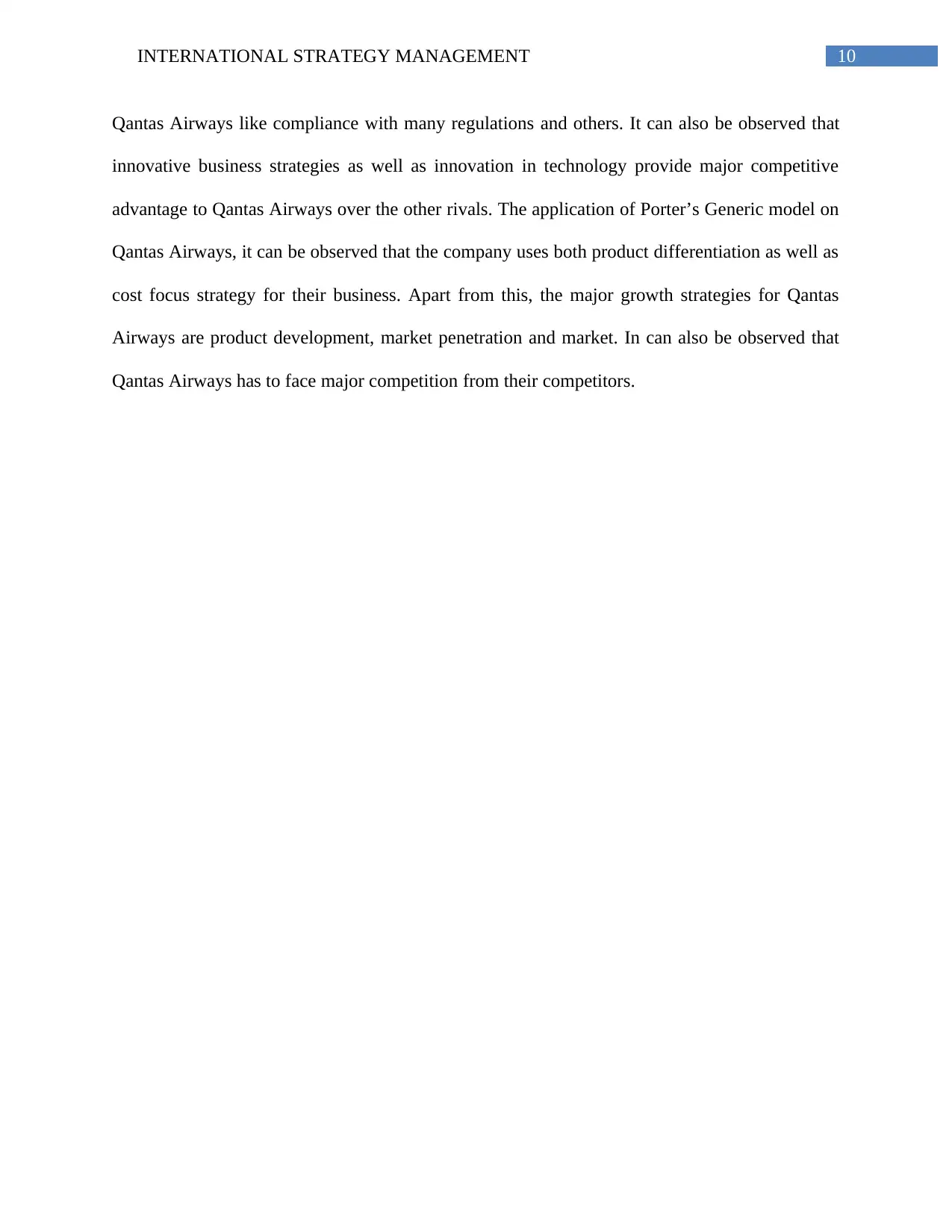
10INTERNATIONAL STRATEGY MANAGEMENT
Qantas Airways like compliance with many regulations and others. It can also be observed that
innovative business strategies as well as innovation in technology provide major competitive
advantage to Qantas Airways over the other rivals. The application of Porter’s Generic model on
Qantas Airways, it can be observed that the company uses both product differentiation as well as
cost focus strategy for their business. Apart from this, the major growth strategies for Qantas
Airways are product development, market penetration and market. In can also be observed that
Qantas Airways has to face major competition from their competitors.
Qantas Airways like compliance with many regulations and others. It can also be observed that
innovative business strategies as well as innovation in technology provide major competitive
advantage to Qantas Airways over the other rivals. The application of Porter’s Generic model on
Qantas Airways, it can be observed that the company uses both product differentiation as well as
cost focus strategy for their business. Apart from this, the major growth strategies for Qantas
Airways are product development, market penetration and market. In can also be observed that
Qantas Airways has to face major competition from their competitors.
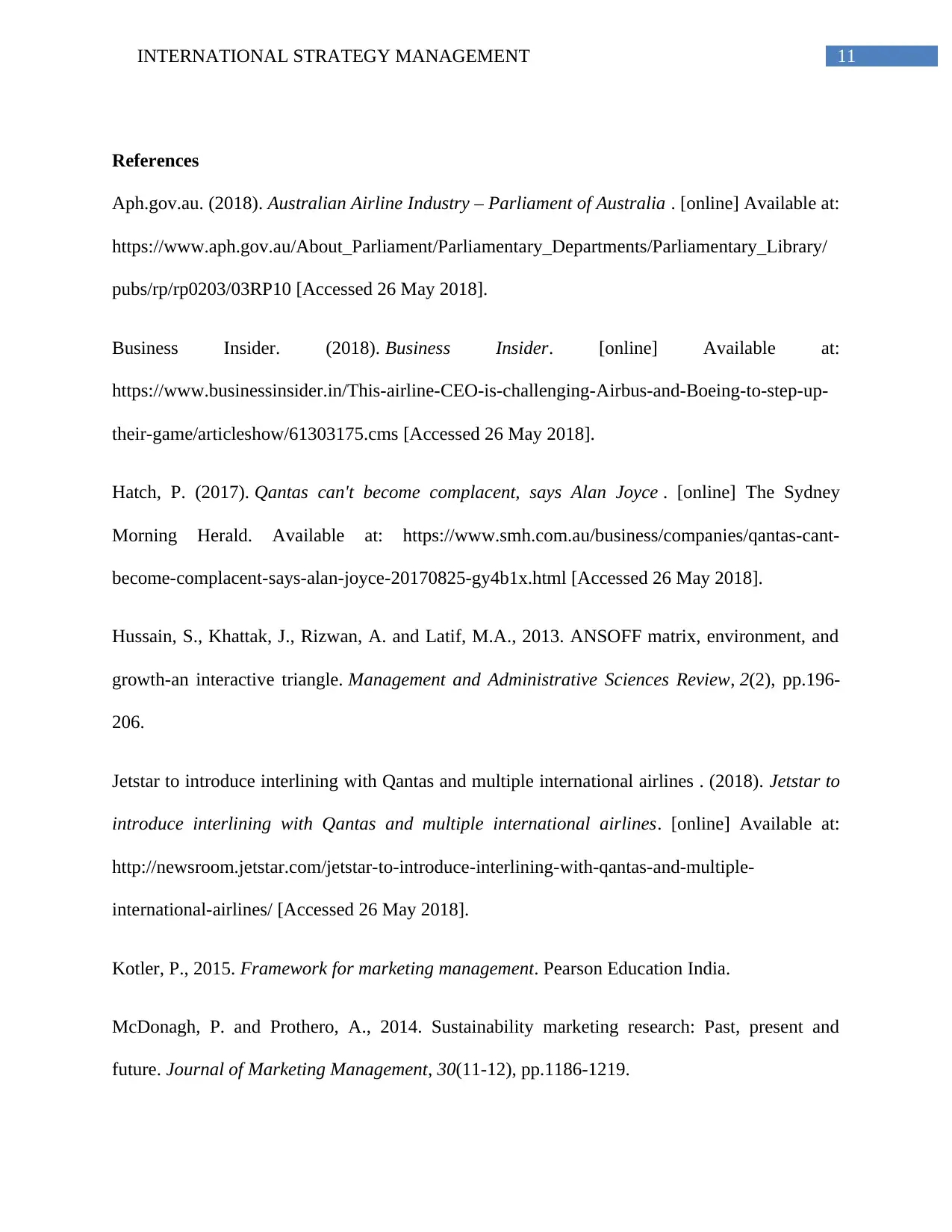
11INTERNATIONAL STRATEGY MANAGEMENT
References
Aph.gov.au. (2018). Australian Airline Industry – Parliament of Australia . [online] Available at:
https://www.aph.gov.au/About_Parliament/Parliamentary_Departments/Parliamentary_Library/
pubs/rp/rp0203/03RP10 [Accessed 26 May 2018].
Business Insider. (2018). Business Insider. [online] Available at:
https://www.businessinsider.in/This-airline-CEO-is-challenging-Airbus-and-Boeing-to-step-up-
their-game/articleshow/61303175.cms [Accessed 26 May 2018].
Hatch, P. (2017). Qantas can't become complacent, says Alan Joyce . [online] The Sydney
Morning Herald. Available at: https://www.smh.com.au/business/companies/qantas-cant-
become-complacent-says-alan-joyce-20170825-gy4b1x.html [Accessed 26 May 2018].
Hussain, S., Khattak, J., Rizwan, A. and Latif, M.A., 2013. ANSOFF matrix, environment, and
growth-an interactive triangle. Management and Administrative Sciences Review, 2(2), pp.196-
206.
Jetstar to introduce interlining with Qantas and multiple international airlines . (2018). Jetstar to
introduce interlining with Qantas and multiple international airlines. [online] Available at:
http://newsroom.jetstar.com/jetstar-to-introduce-interlining-with-qantas-and-multiple-
international-airlines/ [Accessed 26 May 2018].
Kotler, P., 2015. Framework for marketing management. Pearson Education India.
McDonagh, P. and Prothero, A., 2014. Sustainability marketing research: Past, present and
future. Journal of Marketing Management, 30(11-12), pp.1186-1219.
References
Aph.gov.au. (2018). Australian Airline Industry – Parliament of Australia . [online] Available at:
https://www.aph.gov.au/About_Parliament/Parliamentary_Departments/Parliamentary_Library/
pubs/rp/rp0203/03RP10 [Accessed 26 May 2018].
Business Insider. (2018). Business Insider. [online] Available at:
https://www.businessinsider.in/This-airline-CEO-is-challenging-Airbus-and-Boeing-to-step-up-
their-game/articleshow/61303175.cms [Accessed 26 May 2018].
Hatch, P. (2017). Qantas can't become complacent, says Alan Joyce . [online] The Sydney
Morning Herald. Available at: https://www.smh.com.au/business/companies/qantas-cant-
become-complacent-says-alan-joyce-20170825-gy4b1x.html [Accessed 26 May 2018].
Hussain, S., Khattak, J., Rizwan, A. and Latif, M.A., 2013. ANSOFF matrix, environment, and
growth-an interactive triangle. Management and Administrative Sciences Review, 2(2), pp.196-
206.
Jetstar to introduce interlining with Qantas and multiple international airlines . (2018). Jetstar to
introduce interlining with Qantas and multiple international airlines. [online] Available at:
http://newsroom.jetstar.com/jetstar-to-introduce-interlining-with-qantas-and-multiple-
international-airlines/ [Accessed 26 May 2018].
Kotler, P., 2015. Framework for marketing management. Pearson Education India.
McDonagh, P. and Prothero, A., 2014. Sustainability marketing research: Past, present and
future. Journal of Marketing Management, 30(11-12), pp.1186-1219.
⊘ This is a preview!⊘
Do you want full access?
Subscribe today to unlock all pages.

Trusted by 1+ million students worldwide
1 out of 14
Related Documents
Your All-in-One AI-Powered Toolkit for Academic Success.
+13062052269
info@desklib.com
Available 24*7 on WhatsApp / Email
![[object Object]](/_next/static/media/star-bottom.7253800d.svg)
Unlock your academic potential
Copyright © 2020–2025 A2Z Services. All Rights Reserved. Developed and managed by ZUCOL.





